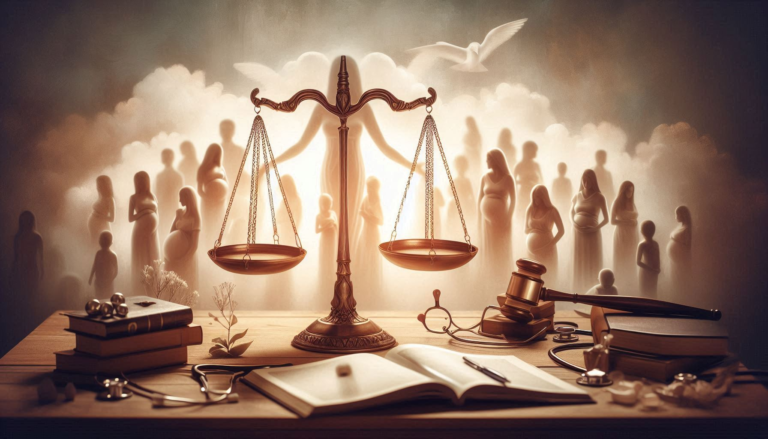
Image Source: https://www.slideshare.net/slideshow/womens-liberation-movement-pp/14571696
Introduction:
Woman, a human being and a social animal like any other person. Women play a very important role in formulation of family. Due to different societal, cultural, and patriarchal norms women were deprived of their rights and representation. After the implementation of our great Constitution of India in 1950 women have been provided autonomy and got the right to represent themselves. The Constitution of India provides equal opportunities to all its citizens and also allows the state to make special provisions for children and women.
Women Rights is a very wide topic in itself. In the present time it is directly connected to Human Rights. The United Nation has a special entity named “UN Women” which is dedicated for gender equality and empowerment of women across the world1. Women rights also include their reproductive rights and have absolute choice over them. Women have the choice for their own reproductive rights and the same are protected under the Indian Constitution. In this article, I will cover a brief history from the vedic period to post-constitution period, situation in contemporary context, landmark judgments, Indian legal frameworks.
Keywords: Women, Reproductive rights, Representation of women,
Brief History:
In Vedic period, women were treated as par to men, even though they were also getting all the rights which were necessary for a human being. They also were allowed to pursue education, including study of Vedas. But in the later vedic period, they were treated as slaves. Due to numerous limitations and the denial of basic human rights, their social standing was diminished. Sexual discrimination began to complicate the situation of women. Child marriage for girls and Sati system were started and widows were not allowed to remarriage2.
New hope emerged after the age of suffering and suppression when Britishers introduced western education in India which impacted the overall society. Father of social revolution Jyotiba Phule worked very hard to abolish the Sati system in India3. The UN Charter was the first instrument, which recognised “the equal rights of man and woman”, and the member states adopting the aims and principle of the UN were supposed to bring an end to any discrimination on the ground of sex. Reforms at all levels were implemented to maintain the equality of both men and women. In this context, women’s rights are not therefore rights which are specific, but are rather universally recognised rights held by all people by virtue of their common humanity and regardless of their sex. The human rights of women and of the girl child are an inalienable part of universal human rights. The full and equal participation of women in political, civil, economic, social and cultural life, at the national, regional and international levels and the eradication of all forms of discrimination on grounds of sex are priority objectives of the international community (The Vienna Declaration and the Programme of Action)4.
Later on, the Constitution of India granted equal rights, including voting rights to women, eliminating gender based discrimination through Article 145,156, and 167. Feminist movement in 1970s and 1980s brought attention on issues like discrimination based on sex, workplace harassment, sexual violence, and dowry. Also the parliament of India has enacted various acts especially for women.
Contemporary context:
In recent years, people have started talking about women rights, which is also connected to human rights which protect rights of men and women both and ensures that there should not be discrimination on the base of sex, color, caste, culture, etc equal opportunities such as education, food, shelter, liberty, etc. The representation of women has increased at a diminishing rate after the enactment of the Constitution. Women’s representation in the State legislative assembly and Lok Sabha has been far from satisfactory; before 2004, the proportion of female MPs in the Lok Sabha was extremely low, ranging from 5% to 10%8. In 1992 and 1993, 73rd and 74th amendments were passed which provided one-third reservation for women in panchayats and municipalities.
However, similar attempts were done between 1996 and 2008, but were unsuccessful. Later on it rose to 12% in the year 2014, which also was not satisfactory9. In September 2023, Parliament through the 106th Constitutional Amendment, gave one-third reservation to women in Lok Sabha and State Legislative Assemblies with the aim to increase representation of women in Indian Parliamentary system & give fair chance to them. It was also hoped to increase the number of women Ministers in the Centre and State. The representation of women in 18th Lok sabha election was increased only to 14% which was surprising that after providing one-third reservation representation was not increased to satisfactory level.
Number of Women Candidates in the Lok Sabha Elections (1957-2019)

Reasons of not increasing representation:
- Lack of education:
One of the most important factors is lack of education. According to the census report of 2011, the literacy rate of India was 72.98% in which the literacy rate of women and men was 64.63% and 80.9% respectively.10
- Patriarchal Attitudes:
We all are aware that in many parts of India there is still belief that women are not capable of doing anything, their only work is to do household chores and nothing more. The child marriage is also very often in India which has restricted women autonomy to a large extent which leds to non-representation.
- Gender-Based Violence and Harassment:
Women are also very often victims of gender based discrimination and harassment. Gender based discrimination was not a small problem for women that new online platforms are being used to abuse politician women. According to study, one out of every seven tweets, has been uploaded to abuse, harass or discriminate against women11. Social Media convenor for Congress named “Hasiba Amin”, said that she faced “traumatising” abuse since she entered politics in 2014. “Rape threats were routine, as were character assassinations, insinuations about my sexual relationships with older men…Now in 2019, I have considerably reduced my activity on Twitter. I ask myself how trollable is that and whether I really need to put up my opinion,” she said12.
Formulation of Reproductive Rights of Women in India:
The concept of international reproductive rights emerged in the early 90s. At the 1994 International Conference of Population Development (ICPD), the world community made a commitment for the first time to shift its focus from state interests to ensuring women’s reproductive rights13. In India, the sphere of reproductive rights was started in 2009 when SC of India in the case of Suchitra Srivastava & Anr v. Chandigarh Administration14 held that “a woman’s right to make reproductive choices is a dimension of personal liberty… under Article 21 of the Constitution of India…reproductive choices can be exercised to procreate as well as to abstain from procreating”, supreme court in this case gave absolute autonomy to women for their own reproductive health and to decide whether to procreate or not.
In the above case women was a rape victim which results to her unwanted pregnancy and she was able to find it at 19-20 weeks of it. The substantiate question before the court was “whether the victim’s pregnancy could be terminated even though she had expressed her willingness to bear a child and whether her `best interests’ would be served by such termination. In conclusion the bench said that “the victim’s pregnancy cannot be terminated without her consent and proceeding with the same would not have served her `best interests’.”
In the case of Laxmi Mandal v. Deen Dayal Harinagar Hospital & Ors15. Delhi High Court held that “maternal mortality is a violation of human rights” High Court also affirmed that “inalienable survival rights under Article 21 include the reproductive rights of mother” this was the first case in the world which has held that maternal mortality violates human rights. Other cases have affirmed that “women’s exclusive and inalienable choice about whether or not to get pregnant, and if pregnant whether to retain the pregnancy and to deliver the child”, a choice that she, and she alone, can make”. Indian courts have time and again given autonomy to Indian women.
Legal Frameworks of India:
The Parliament has enacted and implemented Medical Termination of Pregnancy (MTP) Act, 197116, which directly addresses reproductive rights of women. The MTP Act recognizes a woman’s right to make decisions about her own body and reproductive health, legalise abortion under specific conditions, aims to protect women from being coerced into unwanted pregnancies or forced abortions. Besides the MTP Act17, there are other laws which also indirectly address the reproductive rights of women.
- The Prevention of Child Marriage Act, 200618:
As the name suggest, this act prohibit child marriage and indirectly protects a girls’ reproductive health and allows them to make informed choices about when and with whom to have children. Child marriage often leads to early pregnancies, which can have serious health consequences for young girls.
- The Protection of Women from Domestic Violence Act, 200519:
This Act recognises domestic violence as a human rights violation and provides comprehensive protection to women from various abuse, including reproductive coercion. By addressing domestic violence, this Act empowers women to make autonomous decisions about their reproductive health.
- The Sexual Harassment of Women at Workplace (Prevention, Prohibition and Redressal) Act, 201320:
The purpose of this Act is to provide women with a respect, safe, and sexual harassment- free workplace. By addressing sexual harassment, this Act indirectly contributes to women’s reproductive rights by ensuring their physical and mental well-being. This Act also gives direction to constitute an Internal Complaints Committee (ICC) where there are 10 or more members working at a particular workplace. This committee ensure the safer environment at the workplace and take action against the offender.
Bell Hooks, a famous American Scholar, Social activist and an author of Feminism Is for Everybody: Passionate Politics has well that “If you impose restraints that impede her choice, you are disadvantaging her because of her sex”21, here she talks about social discrimination which is imposed by our society and to restrict women to make her own choices. In patriarchal society this thing is quite common. By evolving time the society has changed and women in present time awarded the gift of their own right but still the society has to change and the time will come where there is no discrimination on the basis of gender.

Conclusion:
Reproductive rights and representation of women in various spheres of life, have seen significantly developed over the period of time. From being at par with men in Vedic period to facing systematic suppression in subsequent time, and finally in the period of post-constitution they got recognition and protection, the journey has been prolonged and difficult. The Indian Constitution has laid a strong foundation for gender equality, while landmark judgments have reinforced women’s autonomy over their bodies and choices. Despite these developments, there are many challenges such as patriarchal mindsets, gender-based discrimination, lack of education, and improper representation of women in Indian politics.
Recent efforts like the one- third reservation for women in Parliament and state legislative assemblies indicate a step forward, but to have true equality requires a collective societal change. Empowering women is not just implementing laws, it is about the collective efforts to create the environment of respect for their rights, recognise their contribution, and perform all the tasks without gender-based biases. Looking to the future, constant efforts are required to ensure that women enjoy equal opportunities, autonomy, and representation in all spheres of life, fulfilling the guarantee of equality given under Indian Constitution and Global Human Rights Charters.
Footnotes
- About UN Women, UN Women, https://www.unwomen.org/en/about-us/about-un-women (last visited Dec. 8, 2024). ↩︎
- Kumar Dogra, N. and Singh, S. (2013) ‘WOMEN TRAFFICKING : A CHALLENGE TO WOMEN RIGHTS IN INDIA’, Indian Political Science Association, 73(3), pp. 396–406. ↩︎
- Id. at 396. ↩︎
- Kaur, S. (2009) ‘Women’s Rights: A Historical Perspective’, The Indian Journal of Political Science, 70(1), pp. 121–130.” ↩︎
- India Const. art. 14. ↩︎
- India Const. art. 15. ↩︎
- India Const. art. 16. ↩︎
- “Rangarajan R, On political representation of women | Explained, The Hindu, https://www.thehindu.com/news/national/on-political-representation-of-women- explained/article68415532.ece.” ↩︎
- Id. ↩︎
- Know India, https://knowindia.india.gov.in/profile/literacy.php, ↩︎
- The Hindu, “https://www.thehindu.com/news/national/women-politicians-trolled-more-amnesty
india/article30631355.ece, ↩︎ - Id. ↩︎
- https://verfassungsblog.de/indias-push-and-pull-on-reproductive-
rights/#:~:text=In%20the%201971%20legislative%20assembly,life%5D%20in%20any%20manner%E2%8
0%9D. ↩︎ - Suchitra Srivastava & Anr v. Chandigarh Administration, AIR 2010 SUPREME COURT 235. ↩︎
- Laxmi Mandal v. Deen Dayal Harinagar Hospital & Ors., [2010] SCC OnLine Del 2234. ↩︎
- Medical Termination of Pregnancy Act, 1971, Act of Parliament, 1971 (India). ↩︎
- Id. ↩︎
- The Prevention of Child Marriage Act, 2006, Act of Parliament, 2006 (India). ↩︎
- The Protection of Women from Domestic Violence Act, 2005, Act of Parliament 2005 (India) ↩︎
- The Sexual Harassment of Women at Workplace (Prevention, Prohibition and Redressal) Act, 2013, Act of
Parliament 2013 (India). ↩︎ - Everyday Health, https://www.everydayhealth.com/sexual-health/on-the-right-to-choose-what-leading-womens-health-advocates-have-to-say/, ↩︎




